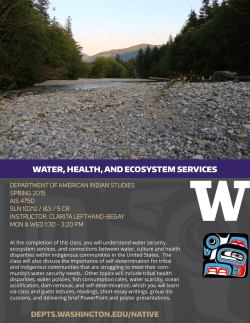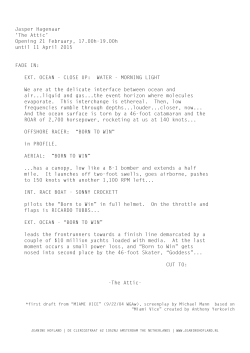
Washington and the Innovation Ecosystem GoGreen Seattle April 30
Washington and the Innovation Ecosystem GoGreen Seattle April 30, 2015 Vikram Jandhyala Vice Provost for Innovation @ UW Executive Director, CoMotion Mission We deliver tools and connections that the UW community needs to accelerate the impact of their innovations. Vision We will be the collaborative hub for expanding the societal impact of the UW community by developing and connecting to local and global innovation ecosystems. UW is Outstanding in Many Metrics $1.4B Highest federally funded state university. Second highest overall. Ranked 8-15 $12.5B World ranking of research impact. Economic impact to the State of Washington. THE UW IS A HUB FOR NORTHWEST START-UPS UW RESEARCH GENERATED MANY OF WASHINGTON’S SUCCESSFUL TECHNOLOGY AND LIFE SCIENCE COMPANIES UW IS THE LEADING SOURCE OF LIFE SCIENCE COMPANIES IN THE NORTHWEST, AND SECOND ONLY TO MICROSOFT AS THE ORIGIN OF TECHNOLOGY START-UPS © University of Washington CoMotion. All rights reserved. How Do We Evolve? How do we take these resources and focus outward to grow and connect to local and global innovation ecosystems? How do we provide an opportunity for UW community across the board to experience entrepreneurial thinking and innovation readiness? How Do We Evolve? How do we take these resources and focus outward to grow and connect to local and global innovation ecosystems? How do we provide an opportunity for UW community across the board to experience entrepreneurial thinking and innovation readiness? Grow programs, spaces, and resources to scale impactful innovation U-District ! Innovation District Maker Spaces Incubators Start-Up Hall Urban@UW Industry Partnerships Programs Innovation Ecosystems Innovation Density Innovation Districts Inclusive Innovation img_brookings_innovation_map.png COLLECTIVELY COLLABORATIVELY Enhance Strategic Relations with External Partners Student Experience Faculty Opportunities UW Innovations into the Community Cross-Boundary Interactions Innovation Ecosystem Models for Open Innovation How do we best mix and match ideas, technologies, and people from UW with synergistic opportunities outside UW http://www.maat-g.com/file/25893/ The Innovation Ecosystem Synergistically connecting with investors, companies, startups, entrepreneurs, govt, alumni, community Be a strong part of building the next “RainForest” in Greater Seattle and Washington State Every major innovation ecosystem has at least one top research university as a key partner and constituent http://ghostnews.lanternghosttours.com/wp-content/uploads/rainforests-can-be-spooky-places-atthe-best-of-times-and-even-mor_159_65129_0_14099571_700-660x330.jpg PNWTOX (Pacific Northwest Toxins) Project UW oceanographers have developed a computer model to track when harmful algae will get carried to Washington and Oregon beaches. The computer model uses sensors that track ocean conditions, then combines them with weather forecasts to generate an ocean prediction for the next few days. Better predictions for when toxic algae may hit can prevent last-minute beach closures, and could give shellfish growers time to prepare and harvest clams before they become contaminated. http://www.washington.edu/news/2014/09/04/predicting-when-toxic-algae-will-reach-washingtonand-oregon-coasts/ Former UW doctoral student Amy MacFadyen (left) deploys instruments to measure harmful algae off the Washington coast. Popcorn-ball design doubles efficiency of dye-sensitized solar cells By using a popcorn-ball design – tiny kernels clumped into much larger porous spheres – researchers at the University of Washington are able to manipulate light and more than double the efficiency of converting solar energy to electricity. With the popcorn-ball design, results show an efficiency of 6.2 percent, more than double the previous performance, using only small particles, which was 2.4 percent. Next, they began working on transferring this concept to titanium oxide based dye-sensitized solar cells to increase the efficiency past 11 percent. http://www.washington.edu/news/2008/04/10/popcorn-ball-design-doubles-efficiency-of-dyesensitized-solar-cells/ UW-made tool displays West Coast ocean acidification data UW oceanographer and technicians secure NOAA ocean-acidification sensors to a solar-powered monitoring buoy in Hood Canal’s Dabob Bay. The IOOS (Integrated Ocean Observing System) Pacific Region Ocean Acidification Data Portal is now a go-to source for ocean acidification data along the West Coast. The tool offers real-time ocean chemistry data for the coast and some Pacific islands, and in protected bays at shellfish hatcheries in Washington, Oregon, Alaska and California. Shellfish growers can use the data to decide when to grow larvae, when to set baby oysters out into the field, and when to draw the thousands of gallons of seawater they need to fill their tanks. http://www.washington.edu/news/2014/11/21/uw-made-tool-displays-west-coast-oceanacidification-data/ Cyclops 1: five-person submarine UW’s Applied Physics Laboratory and Everett-based company OceanGate unveiled the first model of its joint project to build a new type of submarine for human research and exploration in the deep sea. This is the Applied Physics Laboratory’s first project that can take humans far below the water’s surface. Cyclops 1 goes down to 1,640 feet (half a kilometer) with one pilot and up to four passengers who can look out the vehicle’s single big window. The vehicle is eventually intended to be rented to clients for research, resource exploration, photography or even tourism. http://www.washington.edu/news/blog/uw-and-local-company-unveil-new-five-person-submarine/ The “Millennium Falcon” Researchers still don’t fully understand how animals and fish will be affected by ocean energy equipment, and this instrument seeks to identify risks that could come into play in a long-term marine renewable energy project. The robot will deploy instruments to gather information in unprecedented detail about how marine life interacts with underwater equipment used to harvest wave and tidal energy: - Stereo camera to collect photos and video - Sonar system - Hydrophones to hear marine mammal activity - Sensors to gauge water quality and speed - Click detector to listen for whales and dolphins http://www.washington.edu/news/2015/02/05/new-tool-monitors-effects-of-tidal-wave-energyinstruments-on-marine-habitat/ The Bulli) Center Image: Architectural Record “The greenest commercial building in the world.” - http://www.bullittcenter.org/ © UW Integrated Design Lab, 2014 Achieving Sustainable Impact Innovation to real societal impact Broad and diverse Seattle and Washington State Partners in a growing innovation ecosystem
© Copyright 2025











